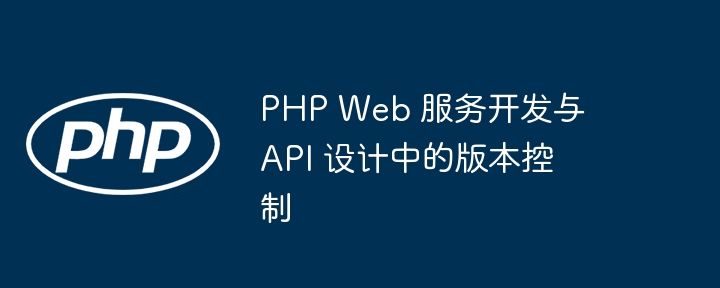 Backend Development
Backend Development
 PHP Tutorial
PHP Tutorial
 Version Control in PHP Web Services Development and API Design
Version Control in PHP Web Services Development and API Design
Version Control in PHP Web Services Development and API Design
PHP Versioning Best Practice: Use the version header to include the version number in the response. Support multiple versions to avoid disrupting existing clients. Ensure new versions are backward compatible unless there are breaking changes. Changes in each version are recorded for clients to be aware of.

Version Control in PHP Web Service Development and API Design
When building RESTful web services and APIs, version control to It's important. It allows you to maintain and update your service while maintaining backward compatibility with existing clients. This article will explore version control practices in PHP and provide a practical example to illustrate its use.
Version Control Basics
Version control involves managing different versions of a service, and each version has a unique identifier. Commonly used identifiers include:
- Integer version number: For example, 1.0, 2.0, 3.0
- Semantic version number: Follow MAJOR .MINOR.PATCH format, for example, 1.2.3
Version Control Best Practices
- ##Use version header: Include a "Server" or "Version" header in the service response to indicate the version number.
- Support multiple versions: Consider supporting multiple versions simultaneously to avoid disrupting existing clients.
- Backwards Compatibility: Ensure that new versions are backwards compatible with older versions unless there are major changes.
- Clear change log: Record the changes made in each version for clients to know.
Practical case: RESTful API version control
Let us look at a practical case of using Slim Framework to build a RESTful API:<?php
use Slim\App;
use Slim\Routing\RouteCollectorProxy;
$app = new App();
// 版本 1 的路由
$v1 = $app->group('/api/v1', function (RouteCollectorProxy $group) {
$group->get('/users', 'UserController:getAll');
$group->post('/users', 'UserController:create');
});
// 版本 2 的路由
$v2 = $app->group('/api/v2', function (RouteCollectorProxy $group) {
$group->get('/users', 'UserController:getAllExtended');
$group->post('/users', 'UserController:createExtended');
});
// 设置版本标头
$app->add(function ($request, $response, $next) {
$response = $next($request, $response);
$response = $response->withHeader('Version', '1.0');
return $response;
});
$app->run();
?>GET /api/?_version=1 GET /api/v2/?_version=2
Conclusion
Version control is an important aspect in PHP web service and API development . By adopting best practices during the design process, you can ensure the maintainability and backward compatibility of your service while adapting to changing client needs.The above is the detailed content of Version Control in PHP Web Services Development and API Design. For more information, please follow other related articles on the PHP Chinese website!

Hot AI Tools

Undresser.AI Undress
AI-powered app for creating realistic nude photos

AI Clothes Remover
Online AI tool for removing clothes from photos.

Undress AI Tool
Undress images for free

Clothoff.io
AI clothes remover

AI Hentai Generator
Generate AI Hentai for free.

Hot Article

Hot Tools

Notepad++7.3.1
Easy-to-use and free code editor

SublimeText3 Chinese version
Chinese version, very easy to use

Zend Studio 13.0.1
Powerful PHP integrated development environment

Dreamweaver CS6
Visual web development tools

SublimeText3 Mac version
God-level code editing software (SublimeText3)

Hot Topics
 CakePHP Project Configuration
Sep 10, 2024 pm 05:25 PM
CakePHP Project Configuration
Sep 10, 2024 pm 05:25 PM
In this chapter, we will understand the Environment Variables, General Configuration, Database Configuration and Email Configuration in CakePHP.
 PHP 8.4 Installation and Upgrade guide for Ubuntu and Debian
Dec 24, 2024 pm 04:42 PM
PHP 8.4 Installation and Upgrade guide for Ubuntu and Debian
Dec 24, 2024 pm 04:42 PM
PHP 8.4 brings several new features, security improvements, and performance improvements with healthy amounts of feature deprecations and removals. This guide explains how to install PHP 8.4 or upgrade to PHP 8.4 on Ubuntu, Debian, or their derivati
 CakePHP Date and Time
Sep 10, 2024 pm 05:27 PM
CakePHP Date and Time
Sep 10, 2024 pm 05:27 PM
To work with date and time in cakephp4, we are going to make use of the available FrozenTime class.
 CakePHP File upload
Sep 10, 2024 pm 05:27 PM
CakePHP File upload
Sep 10, 2024 pm 05:27 PM
To work on file upload we are going to use the form helper. Here, is an example for file upload.
 CakePHP Routing
Sep 10, 2024 pm 05:25 PM
CakePHP Routing
Sep 10, 2024 pm 05:25 PM
In this chapter, we are going to learn the following topics related to routing ?
 Discuss CakePHP
Sep 10, 2024 pm 05:28 PM
Discuss CakePHP
Sep 10, 2024 pm 05:28 PM
CakePHP is an open-source framework for PHP. It is intended to make developing, deploying and maintaining applications much easier. CakePHP is based on a MVC-like architecture that is both powerful and easy to grasp. Models, Views, and Controllers gu
 How To Set Up Visual Studio Code (VS Code) for PHP Development
Dec 20, 2024 am 11:31 AM
How To Set Up Visual Studio Code (VS Code) for PHP Development
Dec 20, 2024 am 11:31 AM
Visual Studio Code, also known as VS Code, is a free source code editor — or integrated development environment (IDE) — available for all major operating systems. With a large collection of extensions for many programming languages, VS Code can be c
 CakePHP Creating Validators
Sep 10, 2024 pm 05:26 PM
CakePHP Creating Validators
Sep 10, 2024 pm 05:26 PM
Validator can be created by adding the following two lines in the controller.





